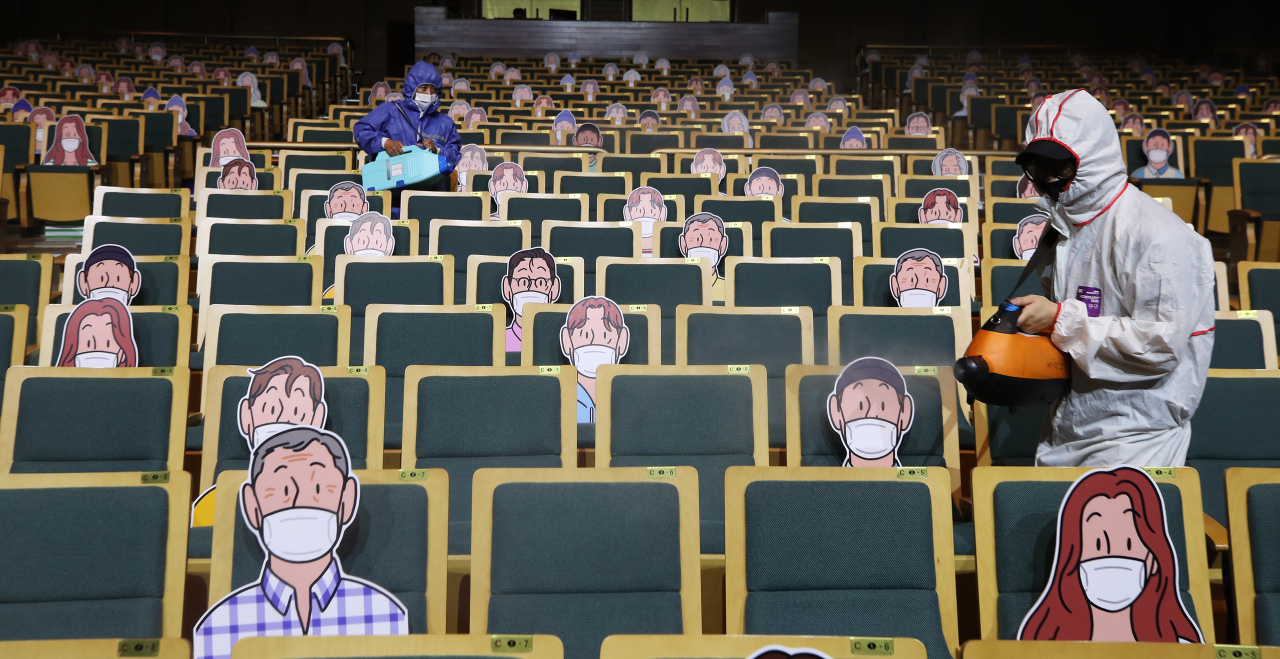South Korea is closer than ever to a lockdown in its second pandemic summer, as record-setting days of new COVID-19 cases continue for nearly a week on end.
Korea counted 1,600 more cases Thursday, down slightly from the record high of 1,615 cases set the previous day. Nearly 70 percent of the freshly logged cases were traced to Seoul and its surrounding areas.
For two weeks starting Monday, the wider Seoul area was under the strictest restrictions available under the country’s four-tier social distancing system. After 6 p.m., all social gatherings larger than three people are banned. Gyms and restaurants can only remain open until 10 p.m. Bars, nightclubs and other places considered to be high risk cannot operate at all.
The constraints on businesses and daily life dictated by the tier are the harshest form of social distancing Koreans have endured since the pandemic began. For now, the rules are set to end on July 25.
While the fourth tier is not a lockdown in a true definition of the word, it’s been widely called a “near-lockdown” or “soft lockdown” due to the unprecedented restrictions on in-person activities put in place. The Ministry of Health and Welfare’s spokesperson Son Young-rae said, “The idea is that you shun all travel and gatherings that aren’t essential.”
Health officials have said that the intense social distancing will not be necessary for long.
Two key promises were made in a series of Ministry of Health and Welfare briefings held Wednesday and Thursday. About 8 million doses of COVID-19 vaccines will arrive in Korea before the end of this month, to hopefully speed up the painfully slow rollout. Additionally, the latest wave will more or less come under control in two weeks.
Baek Young-ha, head of the ministry’s vaccine procurement program, said Thursday that “supplies due for arrival over the remainder of July are roughly 8 million doses,” adding that these have been “agreed upon with pharmaceutical companies,” namely, AstraZeneca, Pfizer, Moderna and Johnson & Johnson. “The vaccine shipments are coming in on a weekly basis,” he said.
Lee Ki-il, another senior official at the ministry, said a day prior that “the COVID-19 situation here is predicted to stabilize in two weeks.”
“For just the next two weeks, refrain from nonessential outings and social events,” he said.
But experts are skeptical that two weeks will be enough to bring the case numbers down to a manageable level.
By the end of July, the size of the current wave could reach 1,800 to 1,900 cases a day, according to one model run by G-ABC, Gachon University’s center for artificial intelligence and big data-based medical analytics. The modeling was based on an R value -- which estimates the number of secondary infections generated per case -- of 1.3 to 1.35 and other metrics from last week.
The center’s director and preventive medicine specialist Dr. Jung Jae-hun said, “Korea is already four days into the new tier, and cases are only rising with no sign of abating.
“Of course, we will have to look at the signals next week, but so far it doesn’t seem like two weeks is going to be enough,” he said.
Hospitals on the frontlines are already being stretched thin, according to Dr. Eom Joong-sik, an infectious disease specialist at Gachon University Medical Center, a government-designated COVID-19 hospital in Incheon.
Since this weekend, Eom said his hospital has been getting requests to take in patients who were stranded without a bed in Seoul. The infectious disease department at the hospital had to reduce its services for non-COVID-19 patients to deal with the recent surge.
“Cases may begin to decline after having the tightened regulations in place for two weeks, but to maintain the downward trend and take the load off hospitals, it’s going to take longer,” he said. He predicted that social distancing of higher intensity will need to go on for at least a month to cut the current caseloads by 30 to 40 percent.
Another infectious disease specialist, Dr. Kim Tark of Soonchunhyang University Medical Center in Bucheon, Gyeonggi Province, agreed that “lifting the current tier of restrictions in 10 days will probably bring us back to an uptick in cases,” calling for “more caution before moving on to a less strict tier.”
But to sustain these restrictions, Eom said there should be more support for people whose livelihoods are hurt by them. “Enforcing social distancing without due compensation will result in eroding people’s compliance with the rules in the long run,” he said.
Korea is also “fighting a different, faster virus spread” now, according to Catholic University of Korea virologist Dr. Paik Soon-young. He said how rapidly cases are growing is likely the impact of delta, which is believed to be the most transmissible variant of COVID-19.
The national disease control agency’s weekly report issued Tuesday said delta now accounts for a quarter of all variant cases discovered in Korea. So far the official count of delta cases stands at 790. But there are at least 776 more people who came into close contact with those infected with delta and are still being investigated.
“The official figures underestimate the presence of variants in the country,” Paik said. Korea was still only analyzing about 15 percent of all patient samples once a week for variants.
The wave, which has thus far been centered in Seoul, is quickly encroaching other areas. Outside of the Seoul area, cities across the country have gone back to midtier restrictions on Wednesday, in less than two weeks since reopening on July 1.
In the last 24 hours, 213,631 doses of COVID-19 vaccines have been administered in Korea. To date, 30 percent of the country’s 51 million people have received at least one dose of a two-dose regimen vaccine, while 12 percent are fully vaccinated.
By Kim Arin (
arin@heraldcorp.com)







![[Today’s K-pop] Blackpink’s Jennie, Lisa invited to Coachella as solo acts](http://res.heraldm.com/phpwas/restmb_idxmake.php?idx=644&simg=/content/image/2024/11/21/20241121050099_0.jpg)
